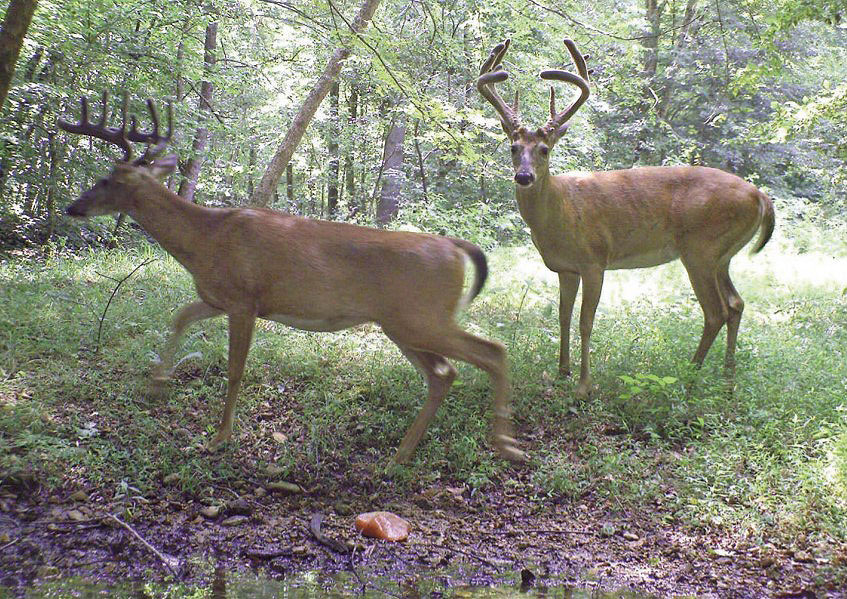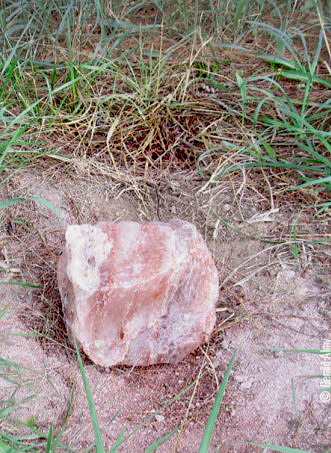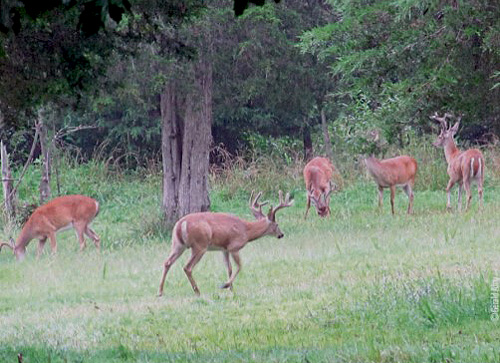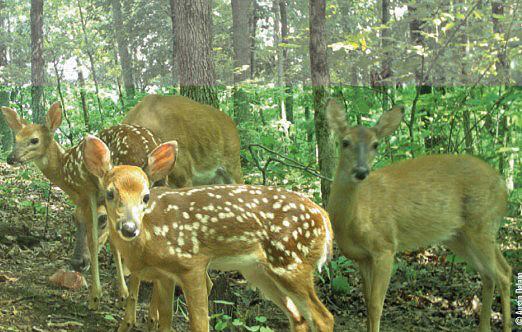Gerald Almy | Originally published in GameKeepers: Farming for Wildlife Magazine. To subscribe, click here.
The buck’s body was huge. That much I could tell even through the dense foliage, but his head was down. I waited anxiously with the binoculars glued firmly to my eyes. When he finally lifted his head I saw a rack with superb mass, four nice points jutting up off the left beam, three on the right and good brow tines. This nine-pointer was definitely a “keeper” in my book.
Luckily for him, he was safe—at least for now. It was summer and I was scouting from a distance to see what animals were using the mineral licks I’d created on my land. Although deer season won’t open again for many months, there are numerous habitat enhancements we can do to improve the wellbeing of our whitetails - everything from fertilizing native foods to boost their production, various types of woods-work, building bedding areas, (and if the ground isn’t frozen) creating small ponds to collect water, planting mast trees, and of course, putting in food plots.
However, if you’re looking for a simpler project perfect for this season - create a mineral lick, or several of them. The goal of a lick is to provide vital minerals, and vitamins to deer and other wildlife species that might be lacking them in the natural foods and soils in the area. Hunting over a lick is illegal in some states and provinces, but that would seldom be a productive tactic, anyway. Animals use these mineral sites, for the most part, from early spring through late summer.

In most areas it’s rare to see a deer going to a mineral lick during hunting season. The reason is that bucks need the vitamins, calcium and phosphorous when they are actually “growing” antlers. (A buck’s hardened rack is made up of roughly 45 percent protein and 55 percent minerals). Does need the nutrients when they are pregnant and then when nursing their fawns - that means utilization occurs during spring through late summer. Minerals play an important role in the health of all animals. They make them eat better, digest food more efficiently, grow larger racks, and reproduce more successfully. Natural licks form in some areas where the mineral supply in the soil is heavy and located near the surface. In most areas, though, natural licks aren’t available and you can help your wildlife by creating them on your property.
Choosing a Mineral
Ingredients in commercially sold mineral mixtures typically include salt, phosphorous, calcium, sodium, vitamins, plus trace elements like copper, zinc, cobalt, magnesium, and manganese, as well as a flavoring agent to attract the deer. There are more mineral mixes on the market than you can shake a stick at. Most recipes will probably benefit deer to a small extent, but to get the most out of a mineral site deer need to be able to absorb the minerals they consume. That’s where Biologic’s Full Potential stands out from other mixes on the market. Theirs are organic trace minerals in amino acid complexes that are immediately bio-available. This formulation allows them to be absorbed into the bloodstream and efficiently transferred to the skeletal system and antlers, unlike many mixtures, which can largely pass through the digestive system without being fully absorbed. Full Potential also contains probiotics to enhance digestive health, yeast to improve rumen function, as well as the crucial vitamins A, D and E.

if you have an average herd density, you can
expect your herd will devour the rock and begin
to create a hole in the ground after a few weeks
to a month.
Two other products to consider are BioRock (a concentrated mix of 50 trace elements) and Whitetail Addiction Chestnut Magic. I like to place a BioRock next to the mineral site and use Whitetail Addiction Chestnut Magic to help attract deer to it when you first create it. The salt and sodium used in mineral products also draws deer, but during the spring and summer, the animals have an actual physical need for them, they’re not just “junk food.”
Whitetails need a correct balance of potassium and sodium in their bodies for proper cellular development and nerve function. According to wildlife biologist Brian Murphy, executive director of the Quality Deer Management Association, “During the spring and early summer, deer operate at a sodium deficiency due to larger amounts of potassium compared to sodium in their natural forage at that time. This interferes with efficient sodium conversion in the body and increases the need for sodium intake. Also, almost all soils located more than 25-50 miles from a seacoast are low in sodium.”
This need for sodium is mainly what draws deer to licks. A quality mineral mix will provide them with the vital phosphorus and calcium they need, plus a good mix of vitamins and micro elements in the precise proportions a whitetail’s physiology requires.
This last point is important. It’s definitely cheaper to buy cattle minerals, but these won’t be appropriate for the needs of a whitetail deer. There will be too much of some ingredients and too little, or none of vital elements that whitetails require. A quality deer mineral mix will also have a large percentage of calcium and phosphorous, vital ingredients for antler growth. Full Potential includes 15-16 percent calcium, and 6 percent phosphorous—the two most prominent minerals in a deer’s rack.
How Many Mineral Sites and Where to Locate Them
Take into consideration the size area of the land and your density when deciding how many licks to put out. As a rule, one for every 25-75 acres is best. For a 50-acre tract, one or two would suffice. On 150 acres, create two to four licks two would likely suffice for low density but four or more may be needed for a high density.
First, locate an area where you’ve regularly seen deer or where there is good sign present, but not close to a road or where there’s a lot of human activity. Possible locations include the edge of food plots (but back in cover), staging areas, bed-to-feed trails and funnels. Deer need to feel safe when they visit a mineral site. To make older bucks feel secure using the site, place it in an area adjacent to fairly thick cover. Austin Delano, Head of Research & Development for BioLogic, even recommends putting one site in a semi-open area for does, fawns and young bucks and another nearby lick in thicker cover for those more secretive and reclusive older bucks.
Avoid wet areas, since the mineral will sink in and spread out. You want it to stay concentrated where you put it. As a rule, clay-type soils hold minerals better than sandy soils.

during a buck's antler growing period and when does and fawns need it
most.
Creating the Mineral Lick
The next step is to clear away sod or weeds if they are present. Dig down four to six inches in about a two foot oval area. Mix eight to 12 pounds of minerals with the dirt and then place this mixture back into the hole. I also sometimes pour a small amount right on top, to help attract deer to the site, or better yet, place a Bio Rock on top of it. You can also just pour the minerals out, but I’ve found deer use it better if it’s mixed with the soil. BioRocks work great just simply placed out. Some wildlife managers put minerals in trays or feeders, but as a rule you’ll get the best usage when they are incorporated into the soil.
Avoid visiting the site too often. I like to wait two to three weeks to see if the minerals have been used and only then add more if required. Make your visits during the middle of the day, being careful not to leave any human scent behind. You certainly can get some good photos of bucks by putting trail cameras at these locations, but I have mixed feelings about this and don’t use them on all my licks. I feel that some old, super-wary bucks may be discouraged from using the site regularly, either spooked by the camera or by the visits to check the camera and retrieve photos. Make your own decision on this issue on a case by case basis.
Why Some Mineral Licks Fail
Chances are if you’ve dabbled in creating mineral licks for deer, you’ve experienced some failures. In other words, deer simply don’t use the site you created. Some hunters have failed with this project so often they’ve simply given up trying to make them, but that’s a mistake. A mineral lick failure can usually be explained by one of several reasons, and avoided by correcting these mistakes:

months are also the most important time for mother doe to get needed
nutrients for her high protein milk.
- You may have too many sites. Deer will show preference to certain sites and you don’t need more than one for about every 40 acres (on average). If they have one within their home range, that’s usually sufficient. If you have multiple licks, deer are going to use the one that fits most fluidly into their daily travel patterns and has other attractive features nearby such as water, cover, secondary foods, etc. You only need one or two for every 50-100 acres. It’s fine to create a few more, but expect some may be ignored. If they are, simply drop them from your mineral replenishment program. Let the deer decide for you which ones are the best.
- It’s in an area that’s too open. Whitetails, for the most part, are creatures of cover. Bucks, particularly older ones, don’t want to be exposed in open areas for very long when visiting a lick.
- It’s disturbed too often or you contaminated it with human scent. Be scrupulous about scent transfer when visiting your lick to replenish the minerals or check cameras. Wear rubber-bottomed boots, spray clothing with scent Improve Herd Health with Minerals continued removers, and do not touch any brush or tree branches around the site. Also locate the site where you can get into and out of it without disturbing bedding deer and visit it only during midday hours.
- The site is on the wrong soil type. Try to locate mostly clay or heavier soils. Minerals tend to leech out of sandy soils fairly quickly and will not hold the vital elements that deer need to continue to attract them. Shaded areas also tend to be better than areas scorched by the sun.
- There are natural licks nearby that deer are using. This isn’t a common problem, but in some areas natural licks provide much of the minerals deer need. In addition, whitetails are creatures of habit so it may take some time for them to become accustomed to your site. You’ll get less usage if this is true, as you’d expect. But if you locate yours in the best spot possible, chances are at least some deer will use it.
Conclusion
By putting in a mineral lick for every 25 to 75 acres of land, you’ll have healthier bucks, does and fawns. And over time, the quality of antlers on bucks should also improve. Remember, 55 percent of a buck’s rack is made up of…minerals! Oh, and that buck mentioned in the lead? I caught up with him in the fall, and he scored in the 140’s gross B&C. Whether that lick helped him grow that impressive rack is impossible to say, but my hunch is “it helped,” at least a little. I think you’ll agree this project is well worth the few hours invested!





























